A panorama of possibilities, along various themes:
A new kind of music -
Weird Effects -
Fun Loops -
Classical, with a twist -
Audio Synthesis
You will find many other contributed samples in the dedicated forum section.
A new kind of music
HighC's inspirer, UPIC, was designed to explore new musical vocabularies, based on novel music theories. These short pieces illustrate this approach:
 Waves: Some wave-like clusters repeated with varying heights and waveform types.
The tutorial lets you recreate it in 5 minutes with repeated cut and paste.
Works great as a phone ringtone.
Waves: Some wave-like clusters repeated with varying heights and waveform types.
The tutorial lets you recreate it in 5 minutes with repeated cut and paste.
Works great as a phone ringtone.
|
 Softnscary: title says it all. Slightly shifted high continuous
drones (the result of copy/paste) install tension and then initiate the
resolution, while narrow-pitched noise bands create an eerie and fuzzy
melodic line.
Softnscary: title says it all. Slightly shifted high continuous
drones (the result of copy/paste) install tension and then initiate the
resolution, while narrow-pitched noise bands create an eerie and fuzzy
melodic line. |
|
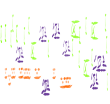 Paper lanterns.
CA Sinclair has produced
Snapshots, a full album using only HighC.
These are two of his creations. Paper lanterns.
CA Sinclair has produced
Snapshots, a full album using only HighC.
These are two of his creations.
|
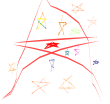 Pentagram.Paper lanterns is also very nice to look at, while the name "pentagram" becomes
quite evident when one sees the score.
Pentagram.Paper lanterns is also very nice to look at, while the name "pentagram" becomes
quite evident when one sees the score.
| |
 Study after Xenakis: this very powerful
sample was created in HighC by rob
then post-processed adding stereo reverb. It is inspired from Xenakis'
Metastasis.
Study after Xenakis: this very powerful
sample was created in HighC by rob
then post-processed adding stereo reverb. It is inspired from Xenakis'
Metastasis. |
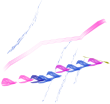 Old fashion. the typical sort of fun
compositions that UPIC allowed to do. Features massive sounds and odd
harmonics. Rising amplitudes and heights throughout the piece replace a
traditional harmonic progression and cadenza to convey some sense of drama.
Old fashion. the typical sort of fun
compositions that UPIC allowed to do. Features massive sounds and odd
harmonics. Rising amplitudes and heights throughout the piece replace a
traditional harmonic progression and cadenza to convey some sense of drama. |
|
Classical, with a twist
Of course, music of all genres can still be created with HighC. Rather than reproducing classical instruments, the following interpretations use novel timbres and effects to renew the listening experience.
These pieces were made using two key features: first, MIDI import allows importing a track played on a conventional instrument: this is needed to give a more natural expression to the piece, that most electronically-generated music tends to miss. Next, rich and specifically chosen timbres and envelopes were designed to replace the original instrument, and turned into patterns. The notes of the initial score were then selectively replaced with those patterns to produce a novel interpretation.
 Mozart: Concerto for Clarinet in A, K622, Andante.
Mozart: Concerto for Clarinet in A, K622, Andante. |
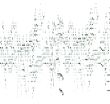 Schubert: Piano Sonata D960, 4.
Schubert: Piano Sonata D960, 4. |
|
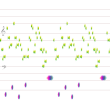 Bach: Cello suite no 5, Sarabande.
Bach: Cello suite no 5, Sarabande. |
||
This is a delicate exercise in taste. The point of this page is to illustrate the capabilities of the software, not to create ground breaking interpretations. Thus, I apologize to Bach and Schubert for any mistreatment of their music you might perceive.
Fun Loops
In regular music production, you'll probably want to use HighC for two particular tasks where it excels: weird sound effects, and loops or short motifs to create a novel and distinctive signature.
These are short loops that should be played repeatedly to form a base line. They are stored as patterns in the base library and so you can reuse them or create your own using the same principles.
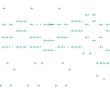 schubLoop: simple treatment of a motif
extracted from Schubert's D958 sonata for Piano. Cheerful and funky.
schubLoop: simple treatment of a motif
extracted from Schubert's D958 sonata for Piano. Cheerful and funky.
|
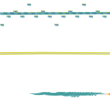 ichWarte: a motif taken from
Einstuerzende Neubauten latest album,
Alles wieder offen (great
album, by the way), treated with lots of modulation and drones.
ichWarte: a motif taken from
Einstuerzende Neubauten latest album,
Alles wieder offen (great
album, by the way), treated with lots of modulation and drones.
|
|
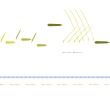 noiseLoop: a simple rhythm loop using noise
bands and glissandi.
noiseLoop: a simple rhythm loop using noise
bands and glissandi.
|
 Alphabet: This is a simple alphabet, in which each letter form a basic beat element. Assembling
letters to form words and sentences using this alphabet is a nice way to produce rich and varied rhythm patterns.
Alphabet: This is a simple alphabet, in which each letter form a basic beat element. Assembling
letters to form words and sentences using this alphabet is a nice way to produce rich and varied rhythm patterns.
|
|
Weird effects, strange instruments
HighC is also useful in regular music production, to create many effects that require a complex program or unintuitive settings on soft synths. Because of its graphical rendition, editing weird sounding effects is much easier than in music-programming systems.
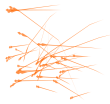 dreamidimachino
Eerie drone by Evelon, one of the first HighC users.
"Delay and reverb were added (impulse reverb with the freeware SIR vst)
in another application.
It turned out pretty good, and people ask me "who created that?", which
I take as a positive result. It truly has a special sound to it.
It could be used both in a horror-movie and a space-exploration movie."
dreamidimachino
Eerie drone by Evelon, one of the first HighC users.
"Delay and reverb were added (impulse reverb with the freeware SIR vst)
in another application.
It turned out pretty good, and people ask me "who created that?", which
I take as a positive result. It truly has a special sound to it.
It could be used both in a horror-movie and a space-exploration movie."
|
 Risset56s: a
Shepard-Risset
perpetually ascending tone. The sounds are not completely equally spaced, to
allow some kind of modulation to be heard in this otherwise fairly long and
monotonous stretch. This is something to retain in HighC: it is often better
to introduce slight irregularities and approximations in a piece, to some
introduce a "live" feeling and remove some of the "perfect coldness" of
electronic music.
Risset56s: a
Shepard-Risset
perpetually ascending tone. The sounds are not completely equally spaced, to
allow some kind of modulation to be heard in this otherwise fairly long and
monotonous stretch. This is something to retain in HighC: it is often better
to introduce slight irregularities and approximations in a piece, to some
introduce a "live" feeling and remove some of the "perfect coldness" of
electronic music.
|
|
 modulated1: just one sound modulated in
frequency by another sound. Because those are not purely sinusoidal, there
are far more harmonics generated than in classical FM synthesis.
modulated1: just one sound modulated in
frequency by another sound. Because those are not purely sinusoidal, there
are far more harmonics generated than in classical FM synthesis.
|
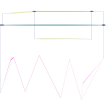 modulated2: a single sound is modulated in
frequency by 2 other sounds assembled in cascade, which are themselves
modulated by a low-frequency amplitude modulator. Just hearing the result
does not hint that there is only one single-tone carrier in this piece!
modulated2: a single sound is modulated in
frequency by 2 other sounds assembled in cascade, which are themselves
modulated by a low-frequency amplitude modulator. Just hearing the result
does not hint that there is only one single-tone carrier in this piece!
|
|
Teaching Audio Synthesis
Because of its graphical nature, HighC is a very good tool to teach the acoustic part of music theory and sound synthesis.
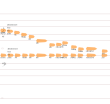 Teaching intervals. This simple
piece lets beginner learn about the "beat" effects, and how various pairs of
tones sound. Because sounds can be manipulated graphically, numerous
exercises can be designed around the HighC model to teach music theory.
Teaching intervals. This simple
piece lets beginner learn about the "beat" effects, and how various pairs of
tones sound. Because sounds can be manipulated graphically, numerous
exercises can be designed around the HighC model to teach music theory. |
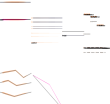 Some synthetic instruments: Violin, Additive Bell,
FM Bell, Clarinet, Bassoon, Brass and WoodDrum. This is a collection
of simple synthetic instruments, inspired from Chowning's seminal paper.
Those instruments can be refined by adding modulation or fine tuning the
relative frequencies of modulators and carriers.
Some synthetic instruments: Violin, Additive Bell,
FM Bell, Clarinet, Bassoon, Brass and WoodDrum. This is a collection
of simple synthetic instruments, inspired from Chowning's seminal paper.
Those instruments can be refined by adding modulation or fine tuning the
relative frequencies of modulators and carriers. |
|
| HighC Kid 1 is an educational and entertaining program for young children between 18 months and 3 years. It is free and can be downloaded here. | ||
Don't forget your samples can come here too: don't hesitate to contribute samples in HighC's dedicated forum section. I sometimes give out free licences when I find the samples illustrate HighC's capabilities quite well!